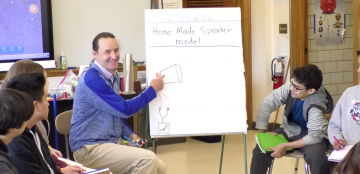
The Power of Why: Empowering Student-Driven Science Learning
“Why do we have to learn this?”
When I think back to my classroom days as a science teacher, I remember feeling as though I let my students down with attempts to answer that frequently asked (and completely reasonable) question.
My replies were always along these lines:
- “It’s part of the curriculum.”
- “It will help you when you get to your next course.”
- “It’s interesting.”
- “Your college instructors will expect you to know this.”
None of these responses satisfied my students. My struggles to justify the classroom objectives and activities merely communicated to my students that the learning I carefully and thoughtfully planned wasn’t actually valuable.
So, what can we do to help students answer this question for themselves?
We can have students chart their own course. That is,
- We can give students thought-provoking and relevant phenomena to explore—and a voice in what that exploration looks like.
- We can show them how science is relevant to their lives by connecting new learning to students’ own experiences.
- And we can turn the tables and ask students “why are you trying to understand this?” so students become stewards of learning.
Harnessing the power of the essential why is an opportunity to bridge the divide between our aspirations for student learning and current levels of science achievement.
Let’s embrace why and facilitate the development of the cognitive tools students need to ask and answer their own questions, take responsibility for their own learning, and contribute to the learning of others within their schools and communities.
Let’s embrace student-driven learning.
Creating conditions for student-driven science learning
Shaping the kind of classroom culture that motivates student-driven learning is a big job.
Teachers are responsible for creating conditions and contexts that drive students to think critically and reason scientifically. Creating such classroom contexts requires important and intentional instructional shifts, some of which may be unfamiliar and feel daunting—to both teachers and students.
What conditions spark student-led scientific explorations and discourse? Here are a few:
- Teachers relentlessly honor and leverage student experiences and viewpoints.
- Teachers nurture motivation and independent thought by promoting student questioning, evidence-gathering, and explanation-building.
- And maybe most difficult of all, teachers step aside and let students grapple with misconceptions by highlighting competing ideas as opportunities for rich scientific argumentation.
Successfully repositioning traditional teacher and student roles necessitates that teachers resist the urge to rescue students from productive struggle (for more, see "Productive Participation," pages 194–204 in Chapter 7: Participation in Scientific Practices and Discourse, in the National Research Council’s 2007 report, Taking Science to School: Learning and Teaching Science in Grades K–8).
That is, when students don’t immediately “get it,” teachers can facilitate shared sense making rather than providing answers “when it gets too hard.” Enabling and requiring productive struggle protects important steps (see, for example, pages 51–186, “How Children Learn Science,” in the National Research Council report) in the process of meaningful learning.
To support this pressing need for instructional changes, teachers and students need high-quality resources that authentically integrate science and engineering practices, core ideas, and crosscutting concepts and that help teachers set the conditions for a culture of student-driven learning and sense-making.
Introducing OpenSciEd
OpenSciEd is dedicated to providing every educator in every school with an open access curriculum grounded in research on what motivates student learning and what pedagogy supports deep knowledge acquisition.
Current OpenSciEd development efforts are focused on middle school, a critical time for fostering student interest in science. The OpenSciEd curriculum provides opportunities to make student thinking visible through lessons that unfold coherently around core learning. Students incrementally build understanding as their discoveries and questions lead the learning.
These units have been written and vetted by science educators, including those from the Dana Center, and field tested in real classrooms. Direct feedback from the field test, from both the students and the instructors, helped guide improvements. The first units of this open source science education resource will be available nationwide in summer 2019.
The OpenSciEd curriculum is aligned to current research described in A Framework for K–12 Science Education and the intent and rigor of the Next Generation Science Standards (NGSS). Each unit begins with an anchoring phenomenon and follows a logical science storyline. Each unit is structured, too, to motivate students to think deeply, plan scientific investigations, and develop evidence-based explanations.
Most importantly, OpenSciEd offers teachers pedagogical strategies to help students work as a community, build deep understanding of important science topics, engage in science and engineering practices, leverage crosscutting concepts to organize and extend learning—and especially to ask and answer their own whys.
About the Author
Shelly LeDoux
My high school chemistry teacher laughed when I told him I wanted to major in math or science in college. He told me those were career paths for boys. I’m glad I didn’t listen to him and proud that I went on to teach AP Chemistry and author a book of chemistry activities. There is no mission more important than nurturing the intellect and aspirations of children.
Get in Touch
We collaborate with state districts and teachers to develop innovative curricula, resources, and professional development.

